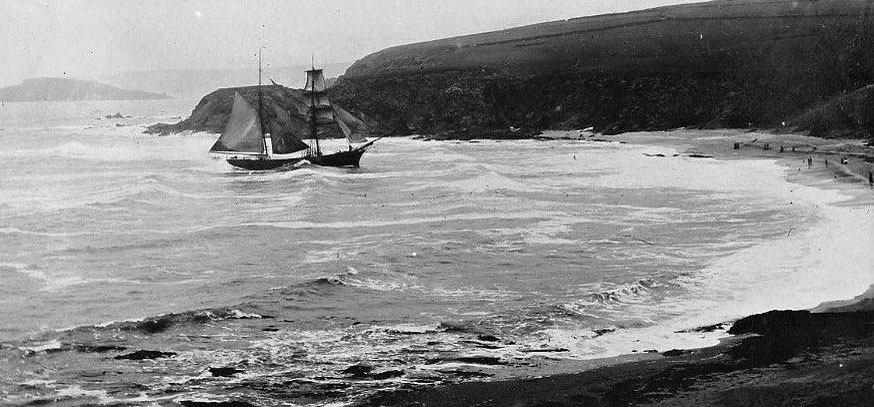
Susan Coney (née Phillips) is a prolific researcher and recorder of Cornish history. This article is about one of her relatives and his ship and is as much an appeal for information as it is the story of a tragic loss of life in the waters that wash our shores.
My great, great Grandfather Josiah Hitchens had a brother called George Rogers Hitchens (my great, great Uncle). They and their 3 siblings were born in Gerrans. Josiah and George Rogers became merchant seamen.
By 1891 George Rogers Hitchens was a Master Mariner and had moved with his wife and family to Charlestown.
In 1908 , George Rogers Hitchens was the captain of a brigantine called The Crossowen which floundered off the coast of south Devon with the ‘loss of all hands’.
The Crossowen was found beached on the morning of 7th May 1908 in full sail – like the Mary Celeste. It is thought that the crew abandoned ship when it hit the rocks off Burgh Island in thick fog. The small rowing boat they were in must have capsized in the breakers as the bodies of the crew were found in the River Avon over the next few days.
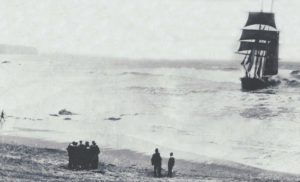 The man in the bowler hat is the owner of the ship, William Charles Phillips of St Austell
The man in the bowler hat is the owner of the ship, William Charles Phillips of St Austell
The owner’s great grandson told me that the name of the brig had been changed and, as every good mariner knows, it is bad luck to change the name of a ship!
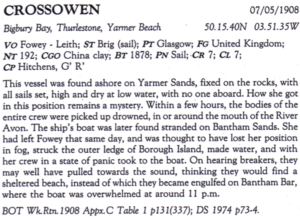
The people of the village of Thurlston paid for a memorial to the crew and captain.
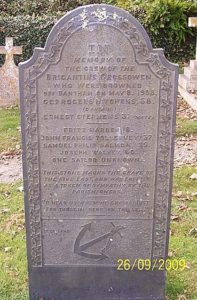 George Rogers Hitchens (Captain) b Gerrans 1841, married Henrietta Warren (Gerrans 1865),
George Rogers Hitchens (Captain) b Gerrans 1841, married Henrietta Warren (Gerrans 1865),
Ernest Stephens (Mate) b St Breock 1877
John Francis Tollervey b Falmouth 1871
Joseph Walkey b St Austell 1848
Samuel Philip Salmon b Cookham Berkshire 1869 (possibly)
Fritz Harder b Southampton 1890 (possibly)
In his book, Devon Shipwrecks, Richard Larn wrote: “Very few wrecks have no survivors at all, and the fact that there were none in the case of the brigantine Crossowen, led to much speculation”. The ship was registered in Glasgow but owned in St Austell. She was found on the beach on the 7th May 1908 with all sail set and less than three feet of water in the hold, yet completely abandoned. Richard continued: “She had embarked a cargo of China clay at Par the previous day and it can only be assumed that shortly after sailing she encountered a dense bank of fog which blanketed the south-west. None of her crew of seven was seen alive again, their drowned corpses being found in, or close to the mouth of the Avon.” He suggests a possible explanation is that she struck Burgh Island and that the crew abandoned her when they thought that she was sinking only to be overwhelmed in the breakers on Bantham Bar. He concludes: “Six bodies were buried together in Thurlestone churchyard, together with that of a boy who, although not part of the official crew, was presumed to have been abroad”.
 This may be the crew of the Crossowen or the crew of another vessel as the Cap’n seated is definitely a Hitchens.
This may be the crew of the Crossowen or the crew of another vessel as the Cap’n seated is definitely a Hitchens.
If anyone recognizes the type of vessel, please let me know so that I can more accurately guess the date of the photograph.
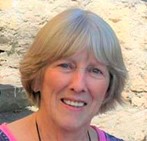 Susan Coney
Susan Coney
Susan grew up near Truro and was educated at St Mary’s School and the County Grammar School. She followed a career in computer science providing and supporting systems for scientific research. Following retirement, she became interested in the history of the people and places of Cornwall.
Susan has written a book about the history of N Gill and Son of Truro and assisted others in their research. She has given presentations to local groups on various subjects of Cornish interest. She was a volunteer at the Royal Cornwall Museum for some years and her history of the Royal Institution of Cornwall Museum buildings in River Street was published in the RIC Journal of 2019.

Another interesting read!!